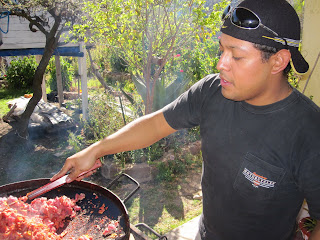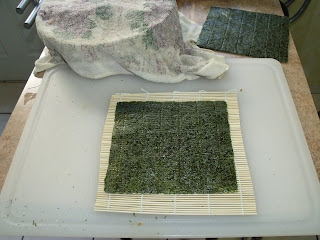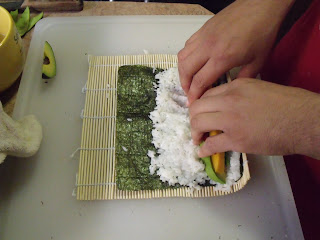
Over the past 10 years or so, there's been a boom of corner sushi stands in my home town. It's unbelievable.
The rice is always overcooked and never seasoned. The fillings so diverse, eating brings back thoughts of Taco Bell and its venomous crap. It's insulting, both to the culture it so poorly imitates and the intelligence and palate of the patrons.
I try to make sushi for my friends and family every once in a while, trying to stay true to japanese recipes and customs. Unfortunately, I still have to make do with the ingredients available and cater to the tastes of everyone, so much to my dismay, you'll find some poetic license in the rolls involved. Enjoy it....
Disclaimer: This being my recipe, there will be copious ammounts of alcohol involved. Also, raw fish is dangerous if handled improperly. So can rice be if not eaten the day it's cooked or after it's been handled (S. aureus and B. cereus). Finally, there's like a million allergies involved. It's your ass, buddy. And this will be a Looooong post. Don't let it disappoint you. I tend to rant.
First things first: THE RICE
Some legends tell us that rice was formed from the bones of the original chinese deity,
Pangu. Since the bones sustain the body, rice sustains the diet. That belief was imported to Japan sometime around the 5th century, where it merged with hindu beliefs and created the goddess
Inari, who grew rice from the remains fo the primal deity.
The japanese word
gohan means both "rice" and "meal of any sort", so it really is a big deal what kind of rice you buy.
There are dozens of japanese rice varieties, all steming form the
Oryza sativa var. japonica plant, and their use varies, not only with type, but also with time of harvest. Italian arborio rice, used for risotto, is believed to have been developed from japanese rice.
You'll most likely be able to find Calrose rice, which is a
japonica breed imported to California in the 70s. It's actually very good for making sushi. It was even considered exotic in some parts of Asia when it reached the global market.

Anyways, the fresher the rice, the less water is needed to cook it, so find rice that has been in the shelves for less than 6 months. This will yield consistent results when boiling.
Sushi rice is glutinous and sticky, but not mushy. A common saying is that good rice should be like brothers: close, but not stuck to each other.
Preparing the Rice
After shipping, the rice will be very dusty. This dust is formed by the grinding of the rice grains against each other, and is mostly comprised of amylopectin, a polysaccaride that takes part in starch. Rice needs to be washed and rinsed several times prior to boiling, otherwise it will solidify into a single block of a disgusting, pudding-like substance and you'll look like a
moron .
If you inspect your rice and find too many broken grains, or a dark strip running down it's edge, it was probably not stored propperly and you should not use it.
You should dump a lot of fresh water on the rice at once, to create tubulence and force the
amylopectin particles to float away from the rice. As you do this, rub the grains against ech other. The rice powder is mildly abrassive and will polish the rice, giving it a glossy surface that is indicative of carefully prepared rice. Repeat 5 or 6 times, until the water comes out clear.
This is not optional
Cooking the Rice
Most likely, you'll find rice that's been sitting on the shelves for 6 months, unless you visit an asian grocery store. If you happen to find fresh rice, it will usually need a rice to water ratio of 4 to 5, and a slightly longer cooking time. The fresher the rice, the closer to 1 to 1 ratio you'll have. Just experiment....
All japanese households own a
rice cooker. I don't. I'm a single man leading a nomadic lifestyle with minimum income, so I improvise. This is called a TMO (or
Typical Mexican Operation ), and if you have enough mexican acquaintances, you know we can McGuyver
ANYTHING (Not to be confused with the
Chicano Fix , which is when a mexican mechanic rips you off).
What I do is I put the rice in a non-sitck pot, add the rice and water (no salt) and cover it with tightly fitting aluminum foil. Make a small hole in the center of the foil and fire it up to the max until it boils. You'll know it's boiling because (duuuuuh) steam is coming out of that little hole. Lower the heat to the lowest setting possible, cover the foil with a tight-fitting lid and wait for about 20 mins.
 |
DO. NOT. PEAK. You will ruin it...
Need I remind you to open a beer??? |
While the rice cooks, make the Seasoning
This is called awasezu , literally meaning "seasoned rice vinegar". It's basically rice vinegar, sugar and salt in different proportions. You can season it to taste, since the flavor varies by regions. Grosso modo , the further west you travel in Japan, the sweeter it will be.
I add 4 tablespoons of sugar and 1 tablespoon of salt to each cup of vinegar. This will season about 3 cups of rice. You can add sake too... but shouldn't you be DRINKING it?! have some right now.
Heat the mixture gently over a low flame until the sugar dissolves and then let it cool completly. DON'T stare at the pot, dumbass, you'll burn your eyes. While it cools, have some more alcohol
Cooling and Seasoning the Rice
Once the rice cooks, let it stand undisturbed for 15 minutes off the stove. This will allow carry-over cooking to finish the rice and make the humidity and texture more uniform. Have another beer while you wait.
Then, dump all the rice at once into a large, non-reactive container. Use metal and you'll stain it with the vinegar and make the rice bitter.. The japanese have a large, round bamboo tub called
hangiri , but mom's beloved salad bowl will do.
 |
| This should be you right now |
Start fanning the hell out of the rice to cool it quickly. I find that a pedestal fan works great. All the while, stir it gently with a wooden spatula. Once it reaches a luke-warm temperature, start slowly and carefully drizzling the rice vinegar all over it, stirring. The rapid cooling and the seasoning will make the polished rice shine. Stop when you reach room temperature and cover with a damp cloth.
That was quite a workout, you need electrolytes.... either put some lime and salt in your beer or mix it with tomato juice.
Preparing the Fillings
Your mise en place is vital here. You're working with raw protein that can spoil quickly. So have all your fillings and sauces prepared ahead of time and arranged neatly in front of you.
If you can pull this off after 6 beers, I'll buy you the next round.
 |
| Clockwise from the top: Lettuce (tachichisa), grapefruit (gurupufruktsu), mango (amazingly, mango), red jalapeños (chiri asa), green jalapeños (chiri midori), carrots (ninjin), cucumbers (kyuuri), and steamed shrimp (ebi) |
|
 |
| Tuna salad (tunasarada): Canned tuna + mayo + Sriracha! |
 |
| Sea scallops (umi no hotate) + soy sauce (shoyu) + jalapeños (chiri midori), marinated for 15 to 20 minutes |
You can fill your sushi rolls (makizushi) with pretty much anything you like. There are no fixed combinations. Still, do some browsing to find more data on your ingredients if you really want to cook the real thing.
This is my all-time favorite sushi book, but there are some great resources online
Now the seaweed (Nori)
Seaweed was traditionally scrapped from pier posts, then ground to a paste and laid out to dry in molds, like paper. Now it's farmed and dehydrated in ovens. Good nori is thick, bright green, plyable and has no holes.
If the nori you buy has tiny pieces in the bottom of the bag, it's probably too old and won't be suitable for sushi. Nori varies from region to region in Japan, but we can't afford such luxuries, can we? So have another beer to drown your sorrows and lay your nori sheet in front of you.
You'll notice it has a shiny bright side and a rough dark side. It's also rectangular. We're making large rolls, called futomaki, and they call for a whole sheet.
Place the sheet on top of the sushi mat (makisu), bright side facing down, long edge facing you. A good makisu is made of bamboo, has 4 to 5 strands of string and is tightly woven, with knots on only one side. Keep the knots facing away from you.
Spreading the Rice
Take about 1/3 of a cup of cooked rice in your hands and lightly roll it into a ball. Now stretch it over the nori sheet in one fluid motion, trying not to mash it. You can lightly damp your fingers in water with some rice vinegar to keep it from sticking to your hands, but don't over-do it or you'll make your rolls all soggy.
 |
| As you can see, the thickness is even without mashing the rice grains to porridge |
Stop about an inch short of the opposite edge and make sure the rice is evenly spread. Make a slight indentation about 1/3 of the way up across the rice with your index finger to keep the fillings from sliding.
Have some more beer, you deserve it. Enchant your victims with some sushi trivia and get them inebriated as well.
Filling your futomaki
Either follow a recipe or get creative. My choices are in the image notes. It'll take some practice to find the balance between the right ammounts of fillings and rice. It'll also take some more beer
This can get a bit tricky, especially if you've been following my beer cues.
Grab a hold of the nearest edge of the makisu with your thumbs, then place the rest of your fingers just past the fillings, now lift and roll tightly, applying gentle, uniform pressure. When the edge of the rice touches the rest of the rice, take the makisu out and re-arrange so you can still roll.
If your rolls are a bit irregular around the edges, take a tablespoon of rice and make a little ball to cover the ends. Finally, apply pressure all around the roll to make it as cylindrical as possible.
Slicing
Get a large (at least 7 inches long), smooth-bladed chef knife and dip it in water. Wipe the blade clean and slice your roll in consecutive halves. Ideally, there should be an even number of slices and it should be a multiple of 4. There's some obscure ettiquete/superstition around that.
Plating
When you serving sushi, think Haiku... simple, clean and highly disciplined... look at pics over the internet to get some ideas... I'm in no position to suggest filling combinations and arrangements, that would be insulting for proper itamaes around the globe.
Add some pickled ginger (Gari Shoga) and
Wasabi to the plate. Ginger cleans the palate so you can distinguish between different proteins. Wasabi is thought to kill some parasites found in raw/undercooked fish.That shouldn't be a problem nowadays, since law requires sushi grade fish to be frozen for 24 hours before being thawed and sliced, to kill
Dyphillobothrium latum eggs and other parasites.
Pairing and Ettiquette
Here's an
awesome video explaining things
 |
| Even in formal settings, eating with your hands is perfectly acceptable, provided they stay clean and you never touch other people's food |
Although it misses a few things:
- It is EXTREMELY impolite to stick your chopsticks (Hashi) on a bowl of rice. It resembles a funeral offering and it sort of means you wish the chef to die.
- Do not take things from other plates with chopsticks that have touched your lips. Either turn them around and take food with the broad end, or have another set.
- If you find it difficult to dip the sushi piece (this post only covers futomaki, but there are several other kinds) in soy sauce, hold a strand of gari with your chopsticks and use that as a brush for the soy sauce
- Try to eat every piece in one bite, unless it's freakishly large
As for pairing, sake and beer are obvious choices, especially more bitter beers, high in hops, like asahi, tsingtao or heineken. Hell, if you get good Mexican Tecates, they're great!
If wine is your poison, a dry german riesling will do nicely. Sauvignon blanc is also a good choice, and also a less formal one. Fruitier reds, like a young Pinot noir will pair well with darker-colored fish and roe.
 |
| You know it's gotta be Anita-approved to be posted |
 |
| AAAAAAND still no casualties, you can trust me |





































































